
by Krista | Jul 13, 2010 | Spring
It was late afternoon in Mostar, Bosnia as we dashed laughing through a sudden rain storm that turned streets into rivers and our merry band into drowned rats. Gasping and dripping we arrived back at our van, shook ourselves like a pack of dogs and clambered in.
I didn’t want to leave.
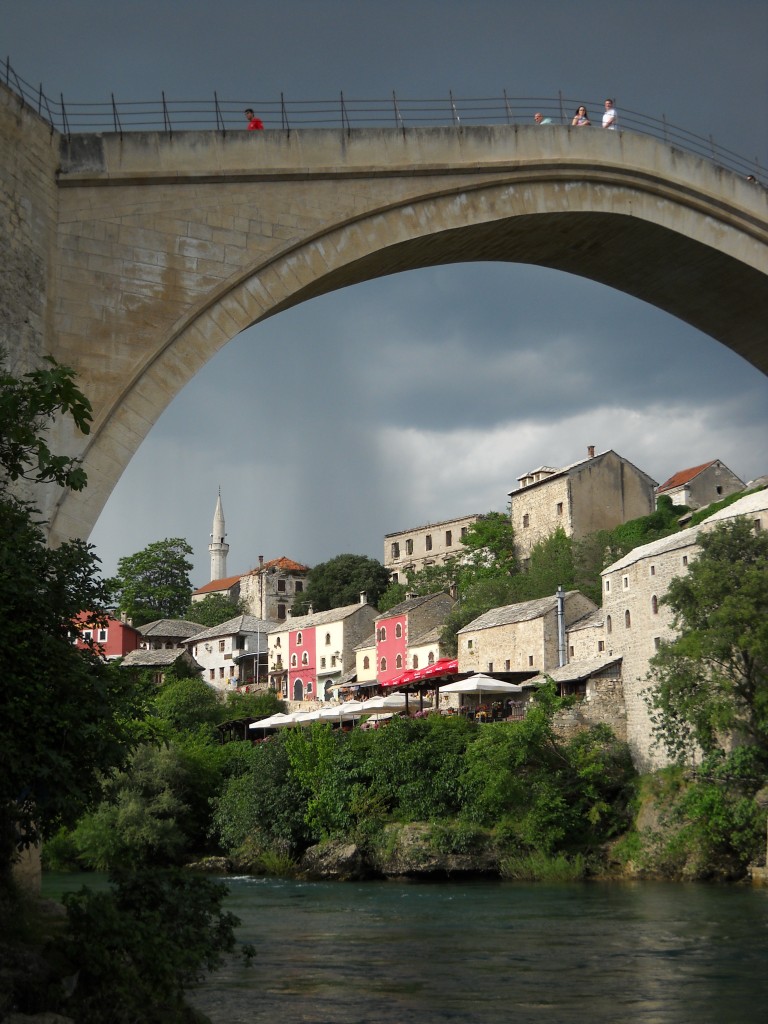
Mostar is a city of rich culture, rebuilding itself emotionally and physically after the devastating trauma and upheaval of the Bosnian conflict in the 1990’s. Some buildings are too battered and gutted to do more than simply exist. Others are being transformed from places of rubble and devastation to ones of beauty and significance. I suppose the same could be said of the people.
I do not claim to understand this beautiful country, but I am grateful to have experienced it. I can’t stop reading about its history, geography, ethnography, even agriculture. I am in awe of people who go through such heartache, loss, and indescribable grief, and wake up each day doing something to make their life beautiful again.
The storm passed quickly and the sun came out as we drove up into the hills above Mostar. We looked back in amazement at the watery fields now glistening in the setting sun.
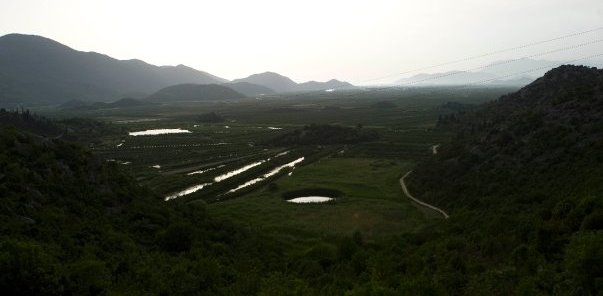
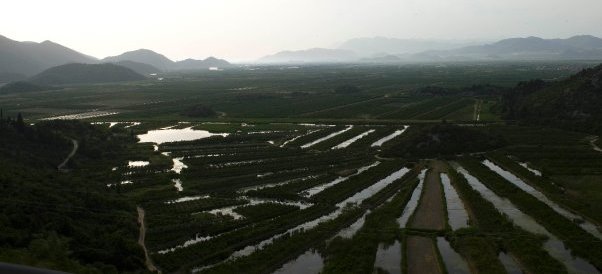
We drove in silence for a while, no small feat with 5 chatty girls in the car, processing what we had seen, learned, and felt during our time in Bosnia. I felt grief, hope, peace, and deep gratitude.
We crested the hill on our way to Croatia and my heart swelled at the sight.
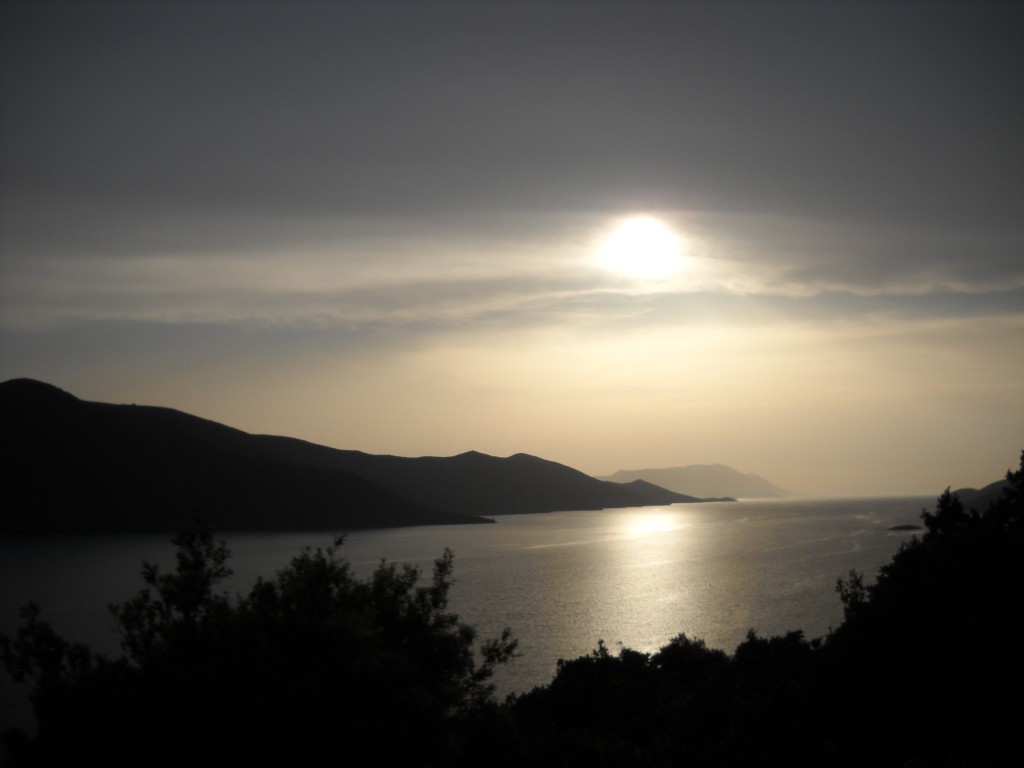
It was a perfect farewell.
Today I’ll share with you a recipe for one of my favorite Bosnian dishes: ajvar. Varieties are also found in Germany, Russia, and Croatia, and they’re all fabulous. A blended condiment of roasted eggplant, red bell peppers, onion, garlic and olive oil, ajvar is a rich, savory sauce that goes beautifully with so many things. I love it as a dip for Bosnian Cevapi, or spread thickly on dark rye bread topped with bacon or salami.
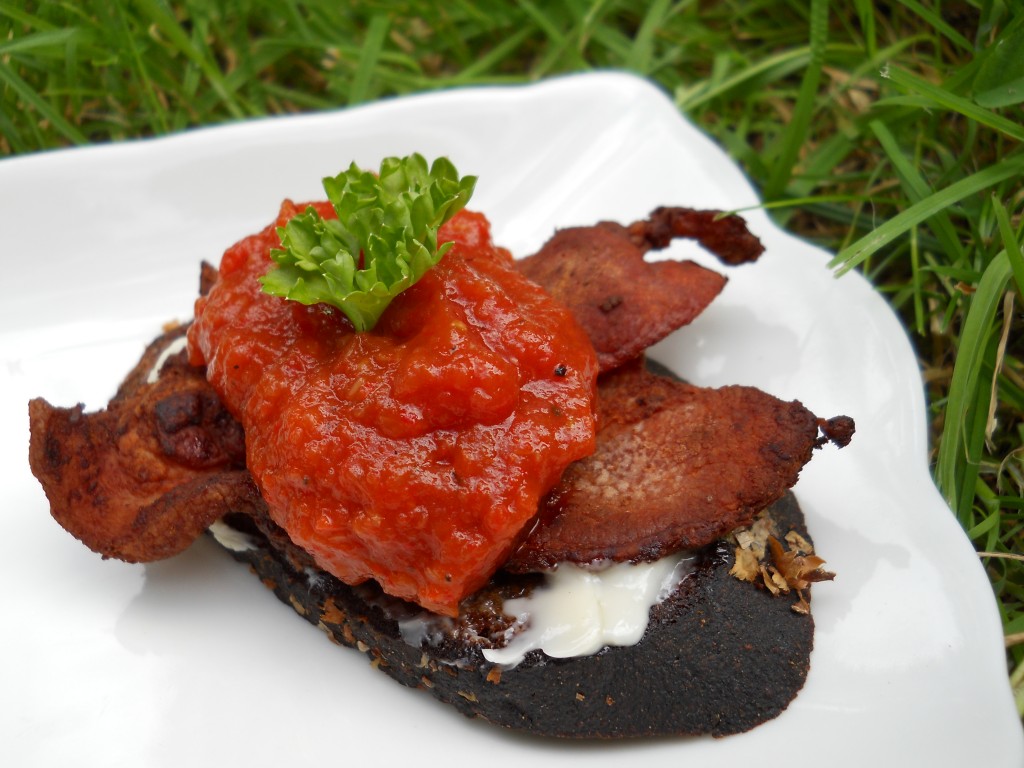
Bosnian Ajvar
Ingredients:
2 large eggplants, washed and dried
6 large red bell peppers, washed and dried
1 sweet onion, skin on, brushed with olive oil
2-3 garlic clove, peeled and minced
Juice of 1 lemon
1/2 cup extra virgin olive oil
Salt and black pepper
Directions:
- Heat oven to 475 degrees F.
- Place eggplant, onion and peppers on baking sheet and roast until their skins blacken and blister, about 30 minutes.
- Put roasted vegetables in a heatproof bowl, cover with plastic wrap and allow them to steam for 10 minutes. This will loosen and moisten burnt skins.
- Peel off and discard blackened stems, skins and seeds.
- Place vegetables in large bowl or food processor depending on the consistency you want. Mash in bowl if you want it chunky, puree in processor if you like it smooth.
- Add garlic, lemon juice, olive oil, salt and pepper. Stir until well mixed.
- Store covered and refrigerated. Can be canned to last longer.

by Krista | Jun 29, 2010 | Spring
Storm clouds loomed threateningly above Mostar, Bosnia and winds whipped flags and awnings as we walked cobbled streets towards Stari Most, an ancient bridge destroyed during the Bosnian conflict in the 90’s and rebuilt.
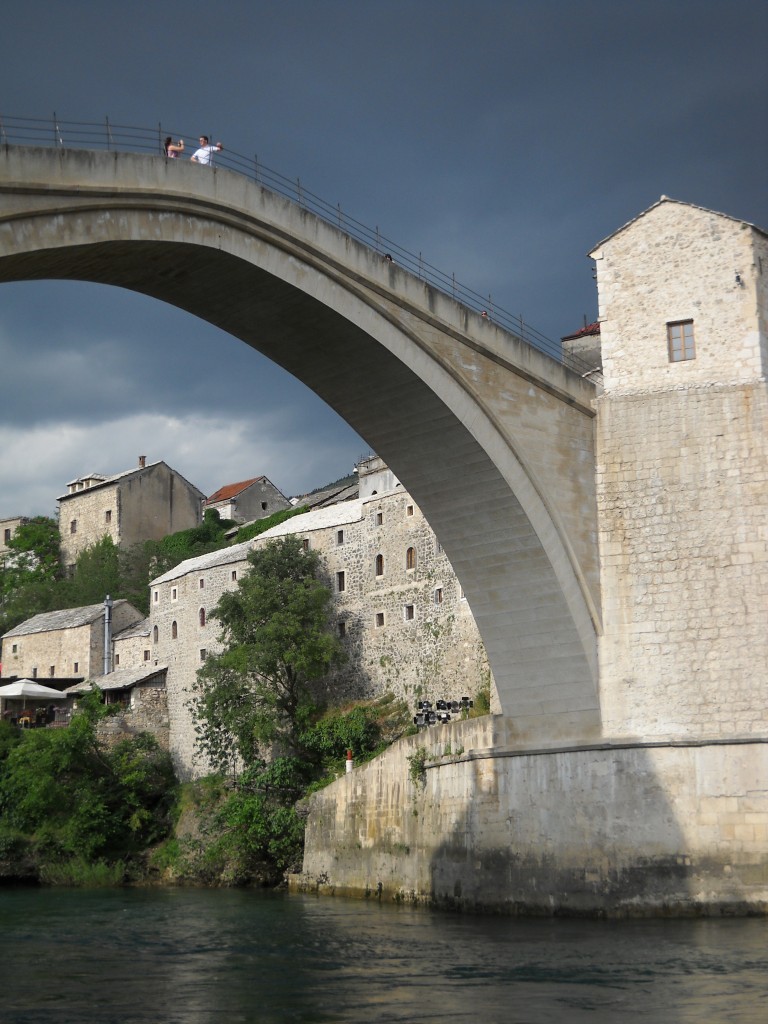
Before it was sent crashing into the Neretva River, Stari Most had stood for 427 years. Nearly from the beginning, the bridge was irresistible to divers who wanted to show their bravery by plummeting into the frigid river below. The first recorded jump was in 1664, and in 1968 a formal diving competition was formed and held every summer until war made it impossible. Diving has resumed at Stari Most, and I hope it will continue for another 427 years.
As we approached Stari Most, we passed this intriguing gentleman who hollered warnings about the end of the world as he strode through Old Town Mostar. He made quite the dramatic figure all in white, his gray hair flying in the wind as he shouted.
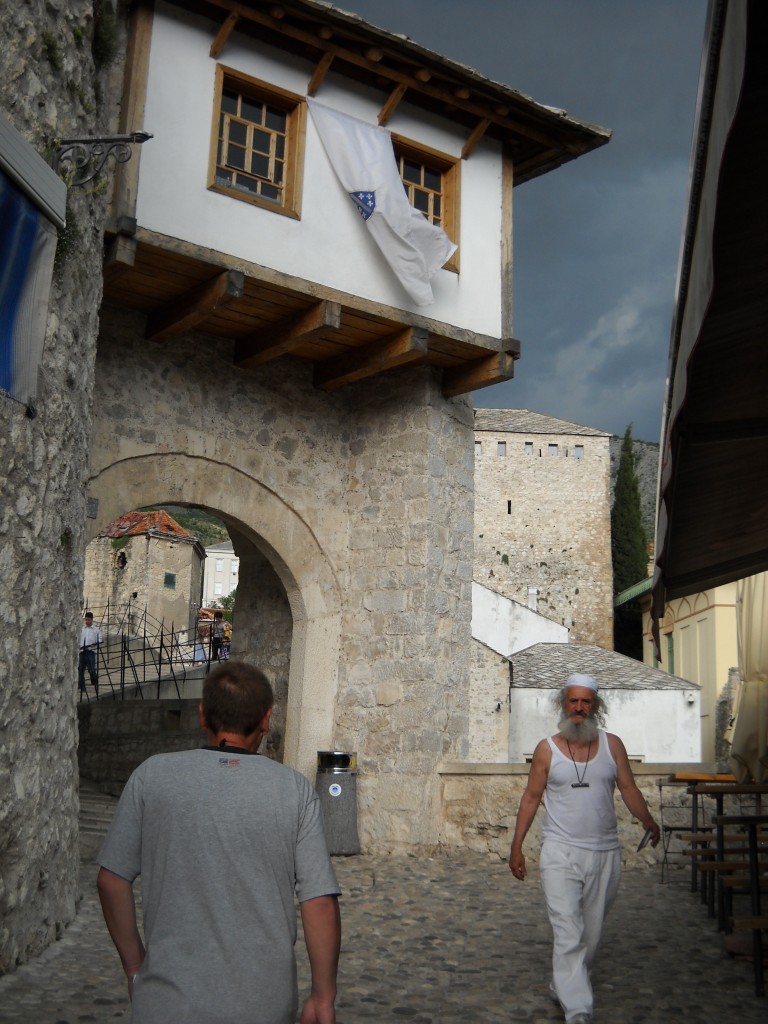
The stones were slick under my sandals and I held on tight to the railing as we walked up the steep incline to the other side.
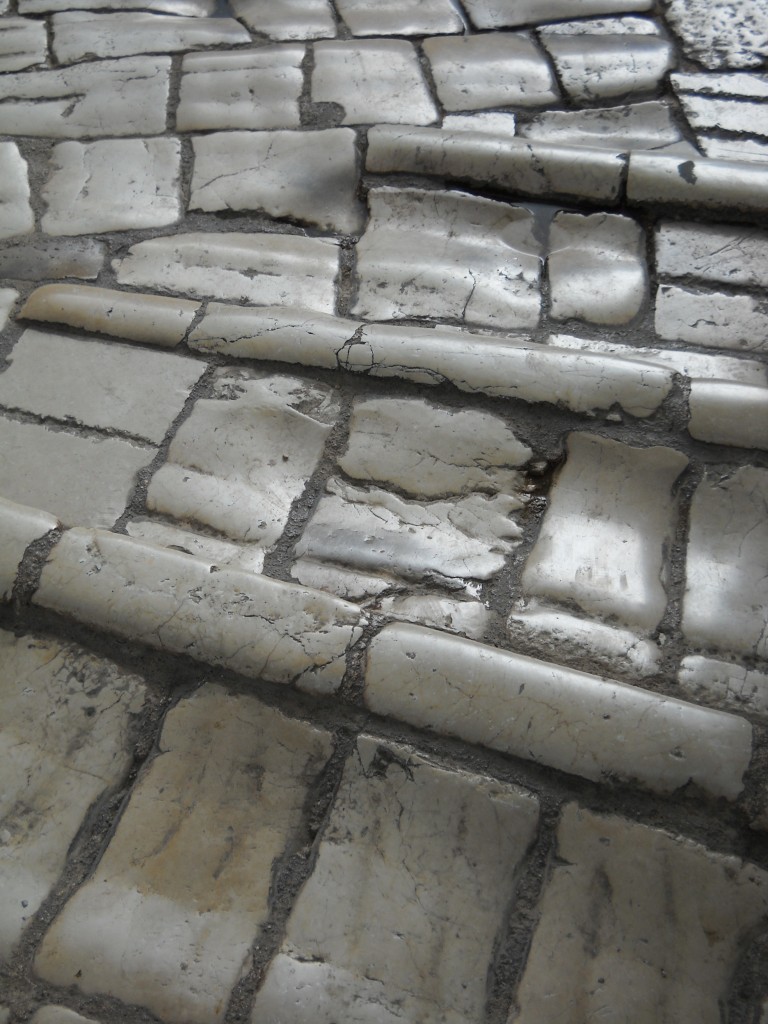
I loved looking at the city from Stari Most. The rumble of thunder, black clouds and strange sunlight made for a gripping vista.
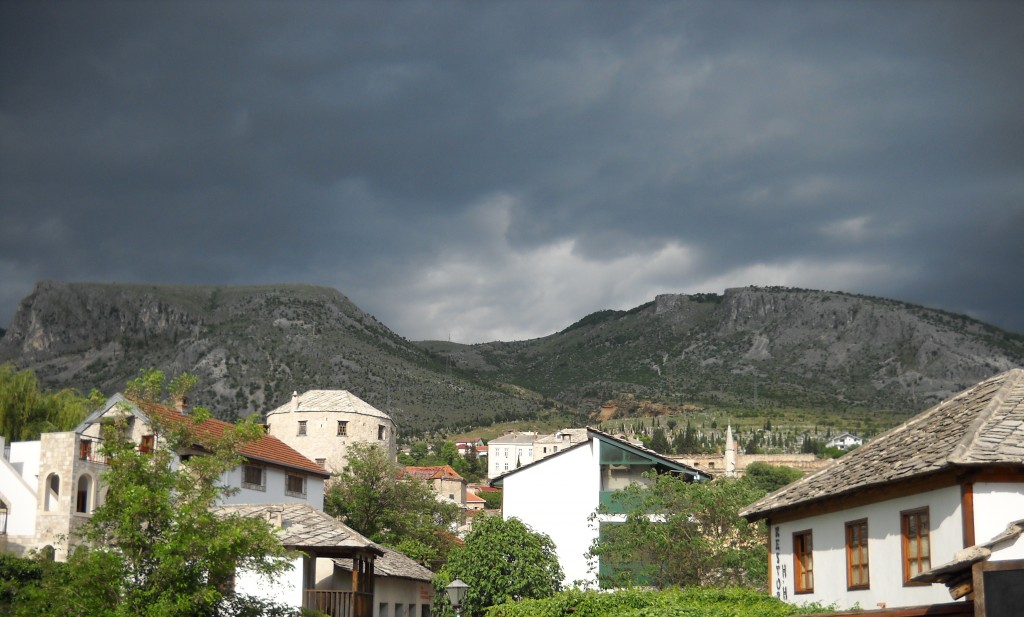
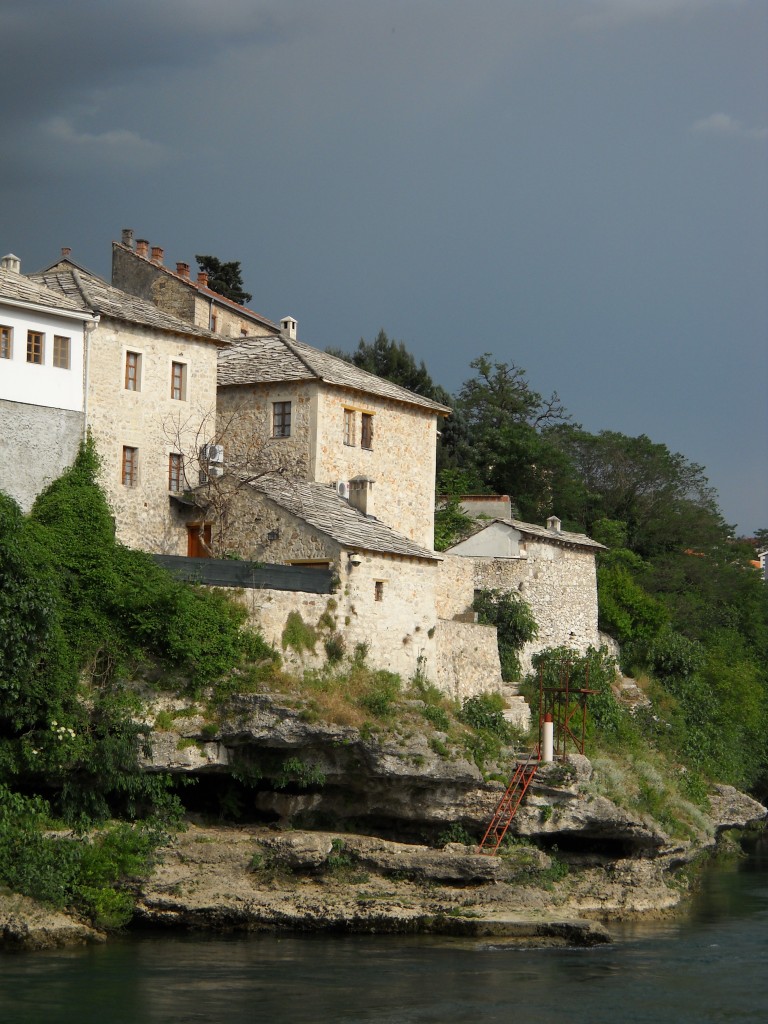
We lingered awhile until suddenly the sunlight disappeared, the heavens opened and raindrops the size of large grapes pelted us with fury. Dry streets were rivers in minutes and we laughed in disbelief as water streamed off us, utterly drenching hair and clothes before we could find shelter. We splashed our way to the van, not even attempting to avoid puddles, and arrived soaked, dripping and laughing like mad.
It would’ve been the perfect night for Bosnian Spinach Pie. Similar to Greek Spanikopita, this phyllo pie features olive oil instead of butter, and a mixture of cheddar and feta cheeses. It also has a topping of sour cream and milk that keeps the pastry soft instead of brittle. It’s my new favorite thing.
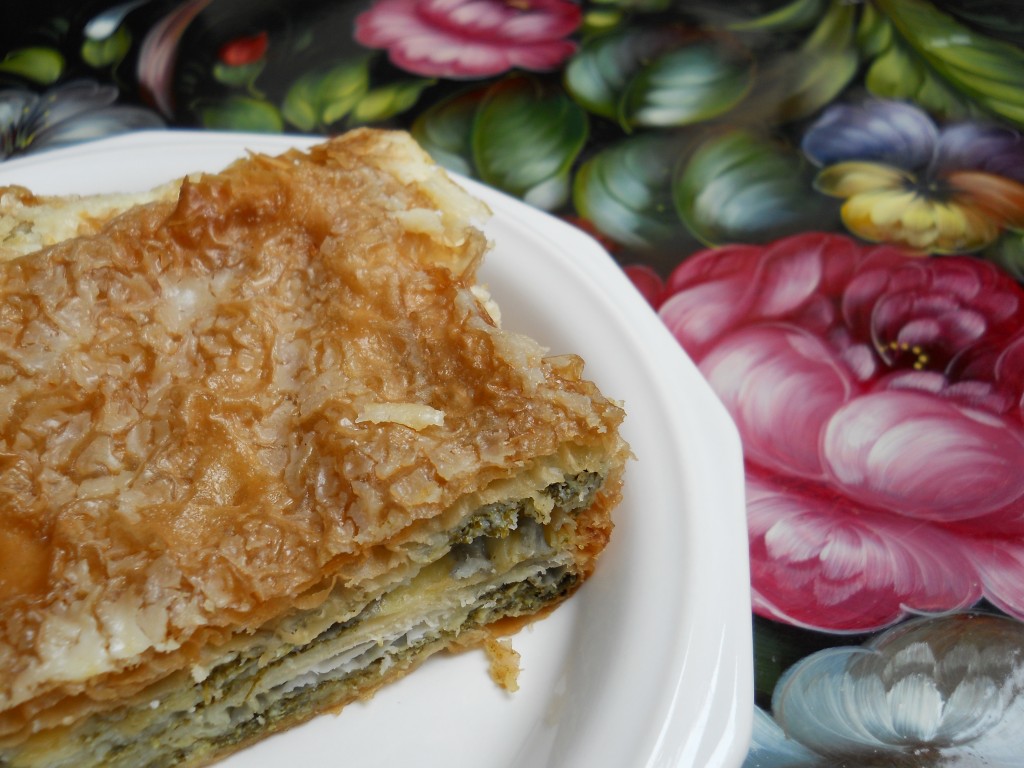
This is my contribution to Wanderfood Wednesday hosted by the lovely Beth.
Bosnian Spinach Pie
Ingredients:
1 package thawed phyllo pastry sheet
2 bags washed fresh spinach
2 medium eggs
1/3 cup sour cream
1 cup feta cheese, crumbled
1 cup shredded sharp cheddar cheese
olive oil
1 1/2 teaspoons salt
1/2 cup milk
1/2 cup sour cream
Directions:
- Preheat oven to 350 degrees F
- Wash and drain spinach. Chop and place in large bowl. Sprinkle with salt and toss until incorporated.
- Let spinach rest for 10-20 minutes.
- Squeeze excess water from spinach and transfer to glass bowl.
- Add eggs, sourcream, feta and cheddar. Mix well. Set aside.
- Grease 9″ by 13″ pan with olive oil. Lay one sheet in bottom (won’t fit exactly, but just press one layer) brush
- with olive oil. Fold over excess dough and brush with olive oil. Repeat with 3-4 sheets.
- Add third of filling and spread over oiled phyllo.
- Top with sheet of phyllo and brush with olive oil. Repeat with three sheets.
- Add next third of filling, three more sheets of phyllo, remainder of filling, and top with final 2-3 layers of phyllo,
- each layer brushed with olive oil.
- Place in oven and bake 45 minutes.
- Combine milk and sour cream. When timer goes off, pour over pie and bake another 15 minutes.

by Krista | Jun 15, 2010 | Spring
The sun was still shining after we finished our delectable Bosnian feast in old town Mostar, Bosnia. Our whistles wet and tummies filled we joined the lovely man we’d met on our way in and he lead us around town with a steady stream of stories and history of his beloved Bosnia.
I was charmed by this stream, bricked in serpentine fashion as it splashed and gurgled its way down to the Neretva river.
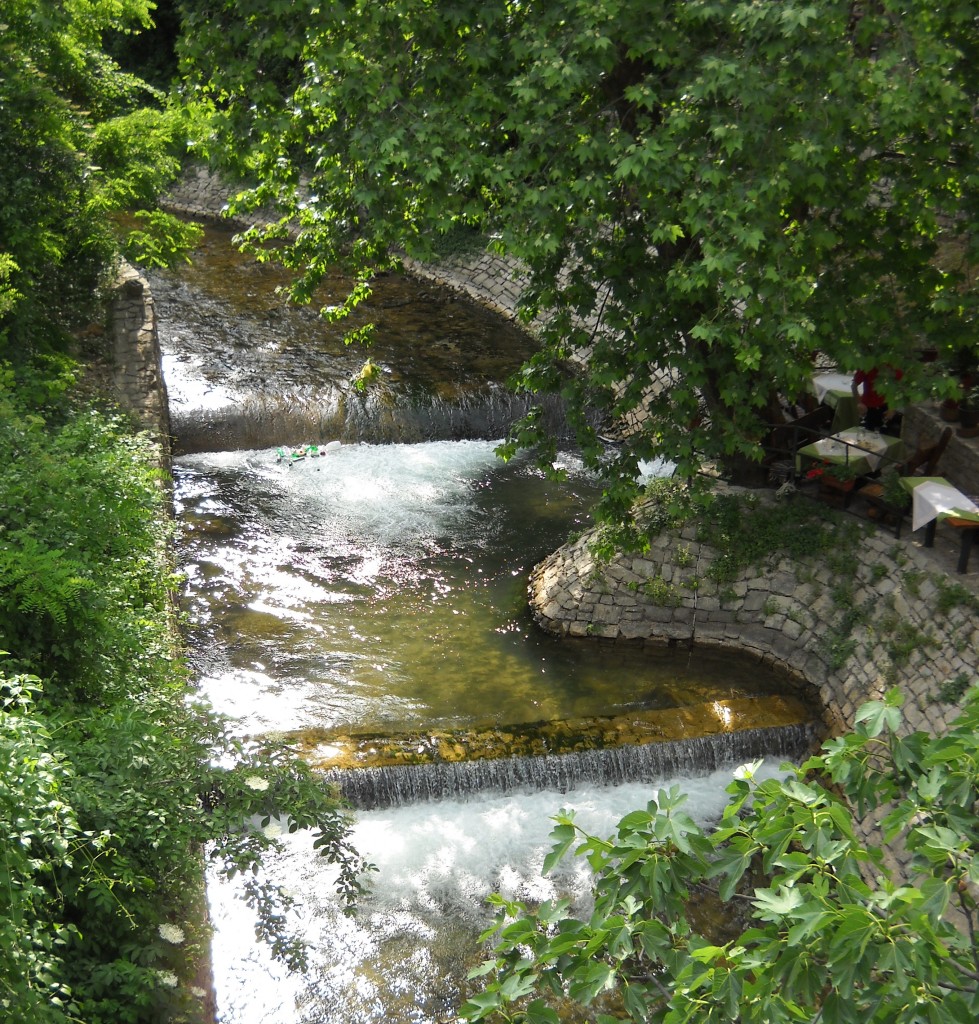
Sunbeams warmed us on our side of the Neretva but storm clouds were brewing in the distance, looming closer and closer with ominous darkness.
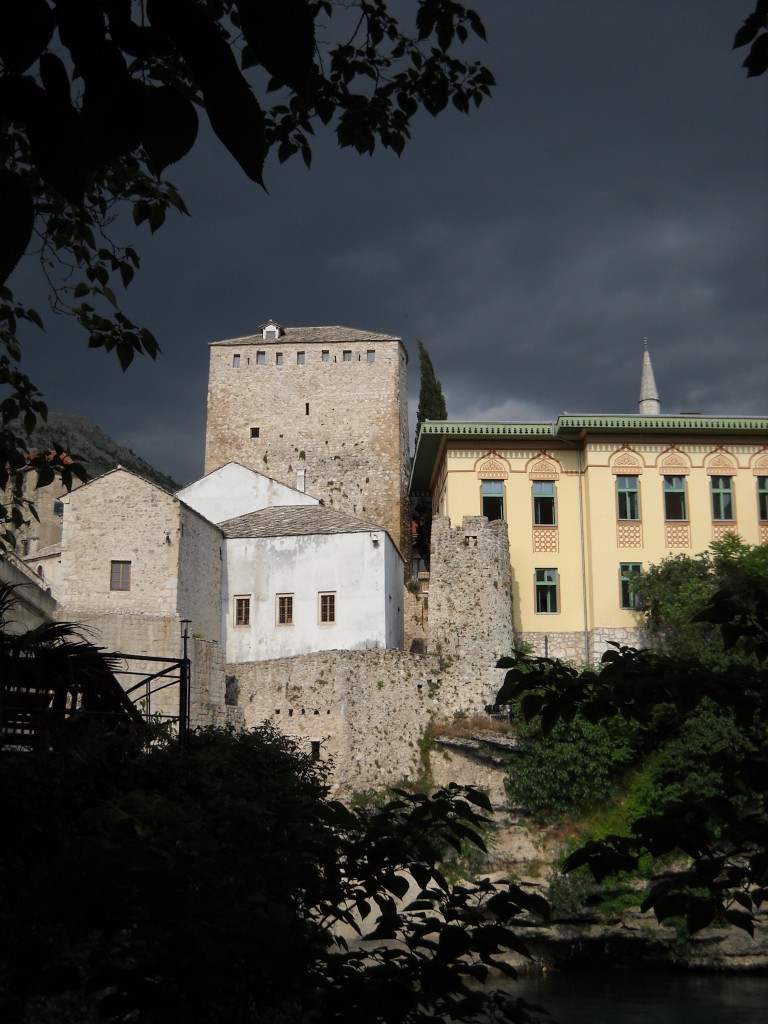
At last we clambered down large concrete steps to the pebbled beach of the Neretva and gazed up at Stari Most, the Old Bridge. Built in the 16th century, it stood for 427 years until it was destroyed in 1993 during the Bosnian conflict. A massive restoration project funded by Spain, Turkey, Italy, the Netherlands, Croatia, and the United States allowed for the restoration of the bridge and surrounding historic buildings and neighborhoods. They did a splendid job.

It is a beautiful part of the city now, children race over the slippery stones of Stari Most, Muslims and Christians pass each other without incident. It’s hard to believe that only a few years ago the citizens of Mostar suffered mass executions, ethnic cleansing, and rape as their city was demolished by heavy artillery.
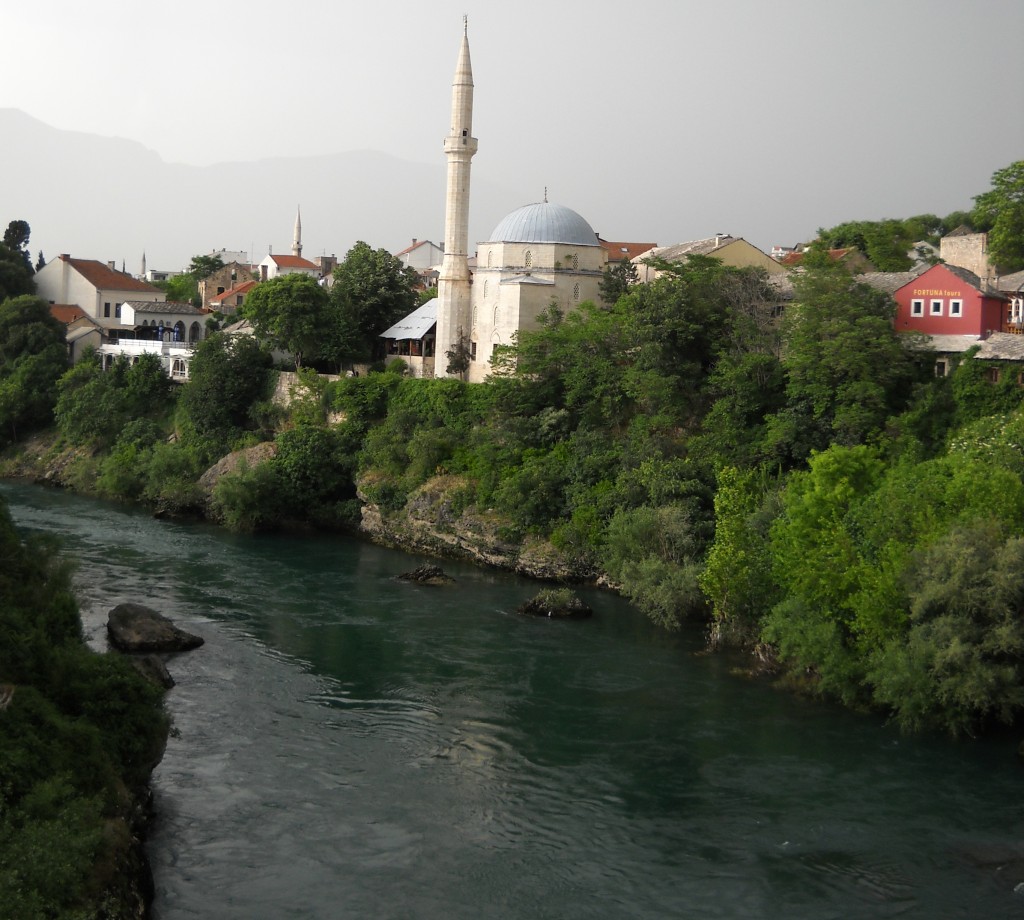
Now it’s the sort of place where you want to linger, visiting with locals in a cafe, sipping demitasse cups of Bosnian coffee, strong and black, sweetened with lumps of sugar.
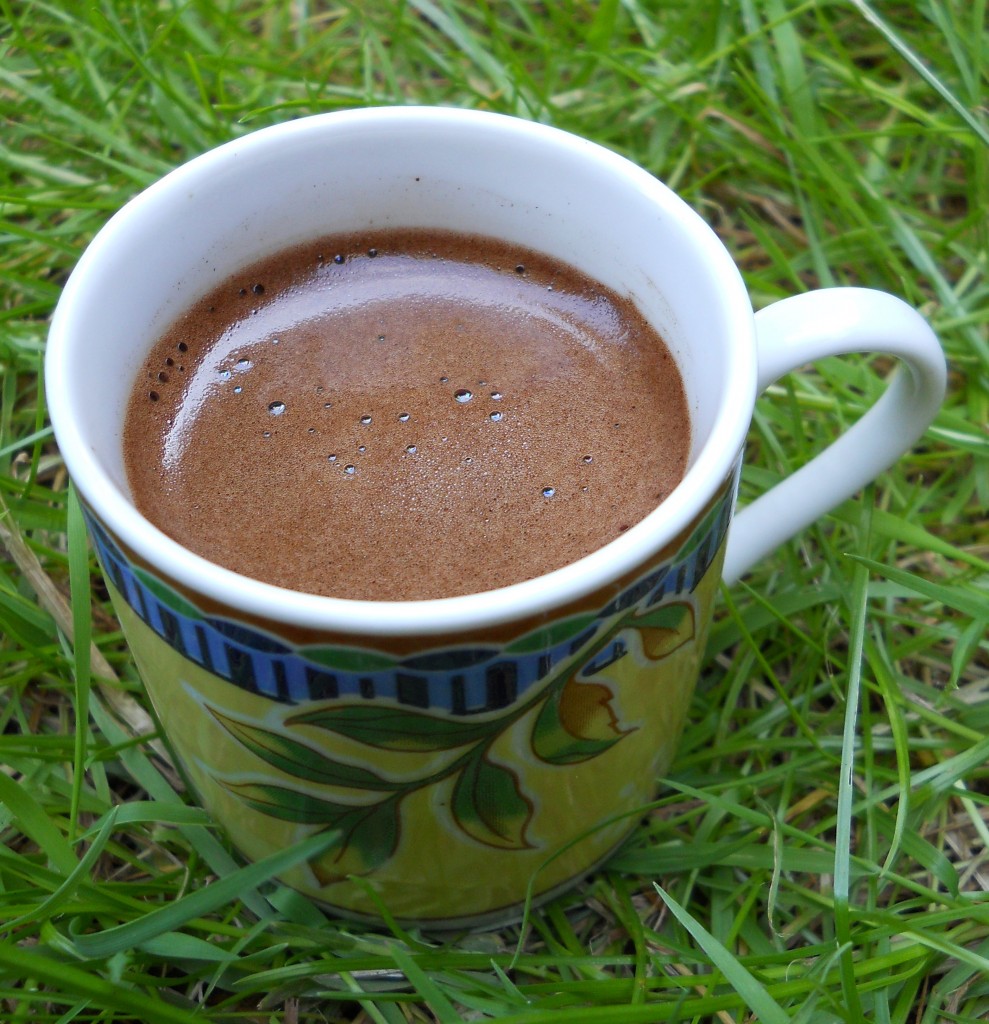
(For more information on the lovely Bosnian coffee tradition, I found this post to be fascinating)
Bosanska kafa (Bosnian coffee)
(Inspired by Bosnian Recipes)
Serves Two
*traditional Bosnian coffee is made in a dzezva, but I do not have one so I used a small pot.
Ingredients:
3/4 cup water
3 Tbsp coffee, ground to fine powder
Sugar to taste
Directions:
- Fill pot with water and heat until it just begins to boil then remove from heat.
- Add coffee powder and stir until well mixed.
- Return pot to heat until foam rises, but doesn’t boil, and remove from heat.
- Spoon a teaspoon of foam into two demitasse cups, add coffee and sugar to taste.
- Let coffee sit a minute or two after stirring to allow coffee grounds to settle.

by Krista | Jun 8, 2010 | Spring
The sun was blazing hot as we emerged from the gorgeous Bosnian mountains and wended our way through the battle-scarred valley to the city of Mostar.
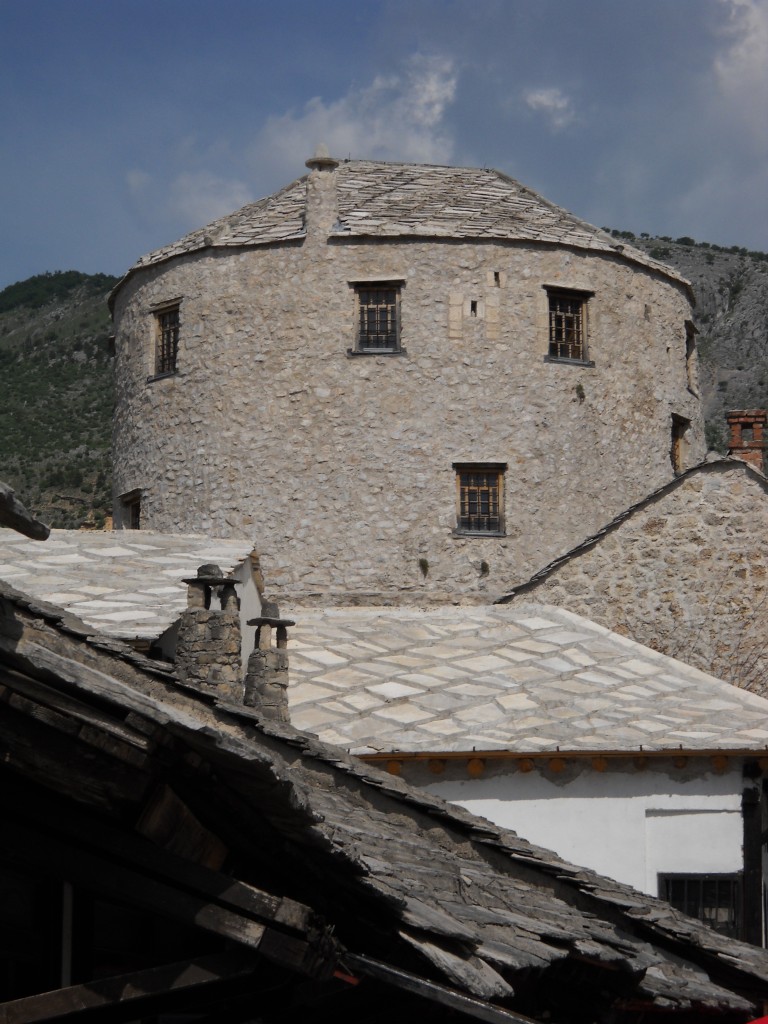
Wanting to explore the old town and see the bridge we’d read so much about, we stopped a man by the side of the road to ask directions. Not only did he give us directions, he offered his services as our guide and historian. An offer we gladly accepted.
He led us from the sun-baked asphalt onto the stone streets of Old Town Mostar, my sandal clad feet slipping precariously on the stones worn smooth as glass.
Captivated by the beauty of our drive through the Bosnian countryside that day, we had completely forgotten to stop for meals and were positively ravenous and utterly parched! Our guide immediately took us to a restaurant featuring traditional Bosnian fare. I knew I wanted to eat there as soon as I saw we’d be eating under a flowered arbor, next to a gurgling fountain, and that we got to cross this exquisite carpet to gain entrance.
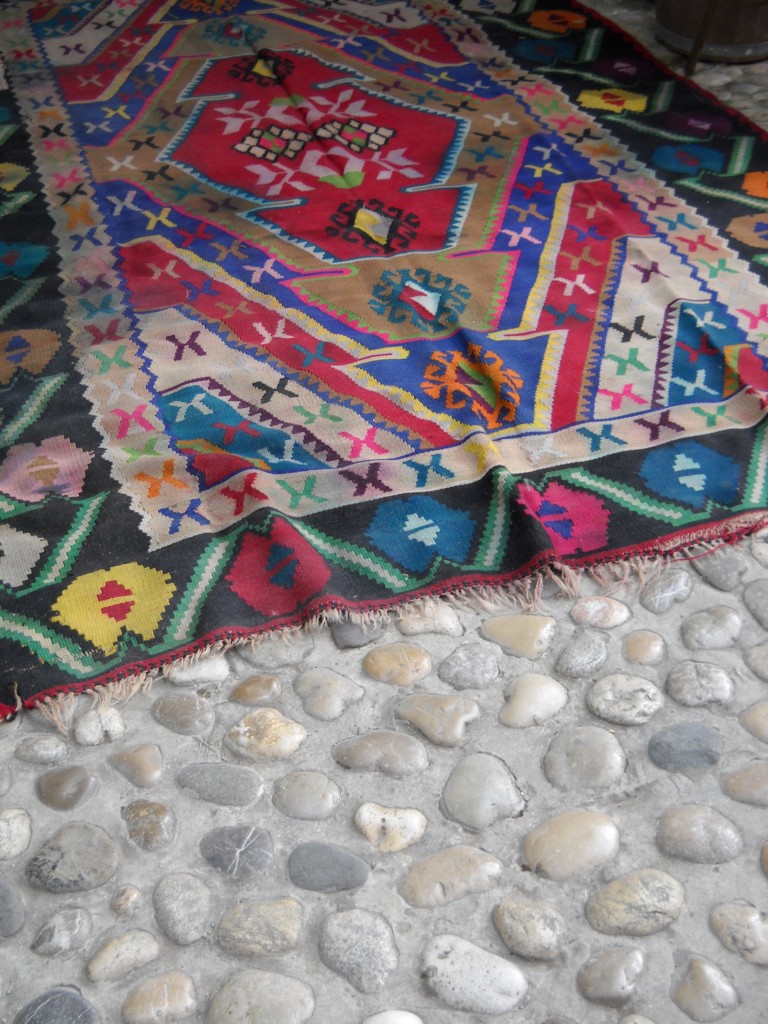
We had scarcely taken our seats when we were visited by the restaurant cat.
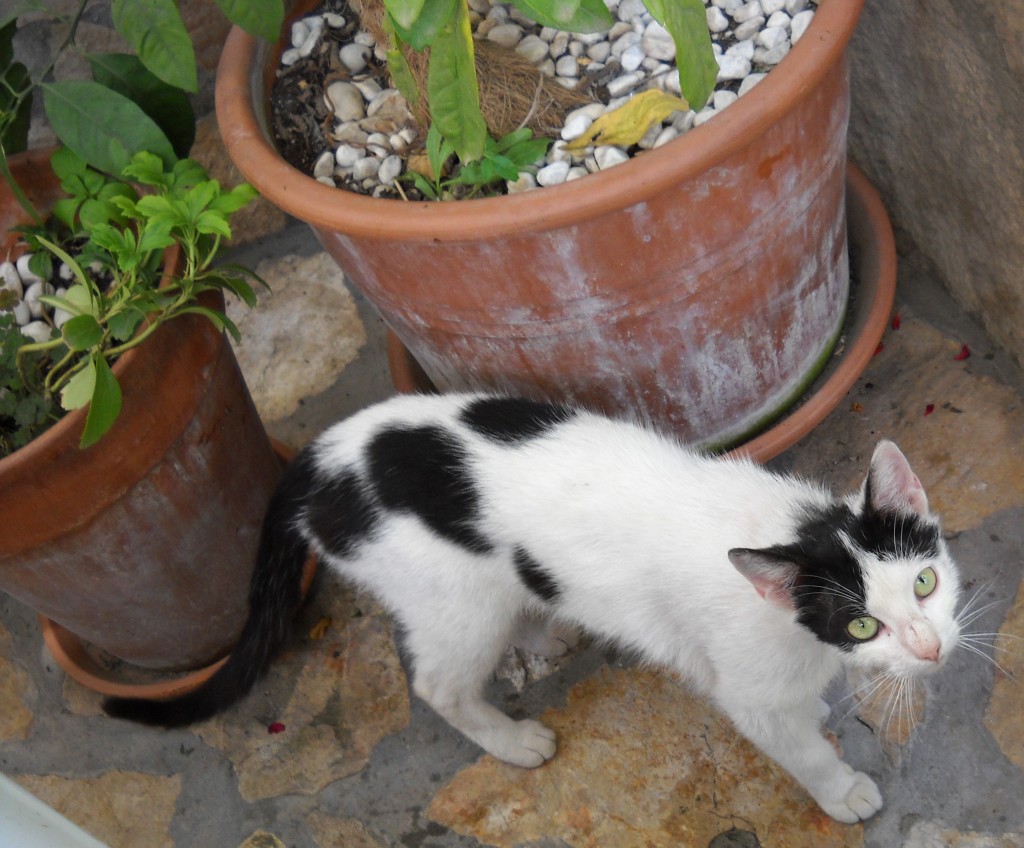
Too hot and thirsty to even think of food, we hastily ordered mineral water and flat water and guzzled to our heart’s content.
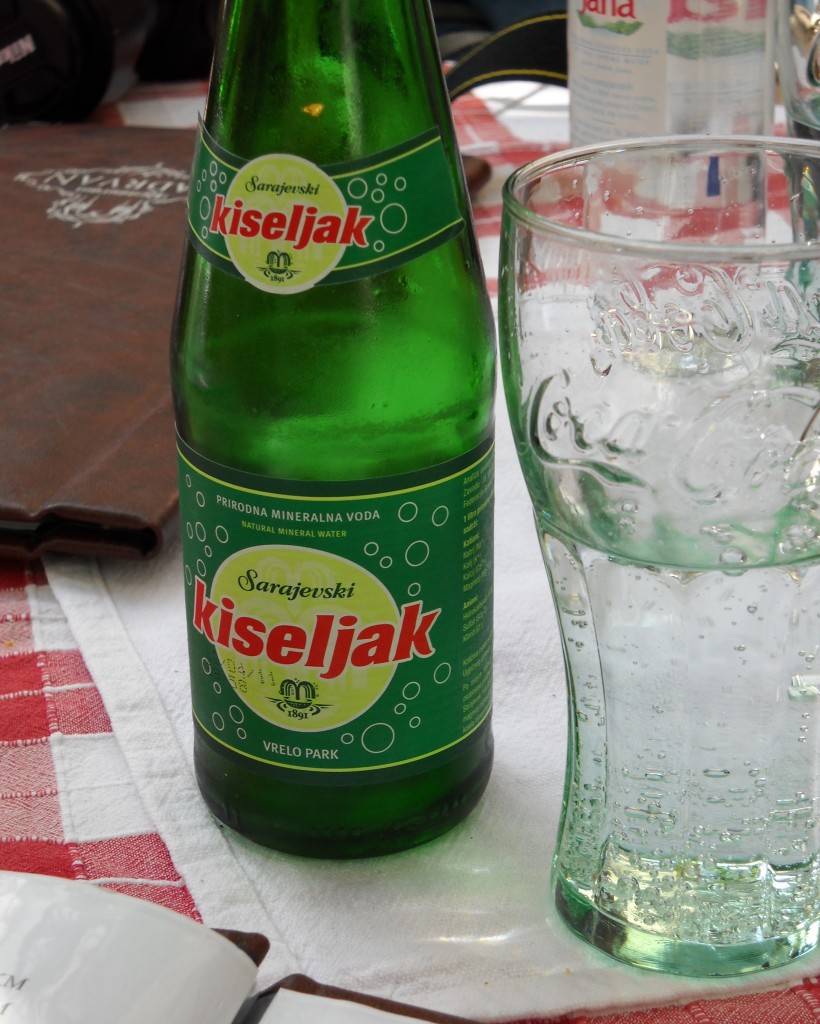
My brother Ryan went for a massive platter of grilled cevapi, sausages, and other meats, grilled eggplant and mushrooms, cabbage salad, tomato salad, French fries, and ajvar, that wonderful roasted vegetable condiment beloved from Germany down through the Balkans.
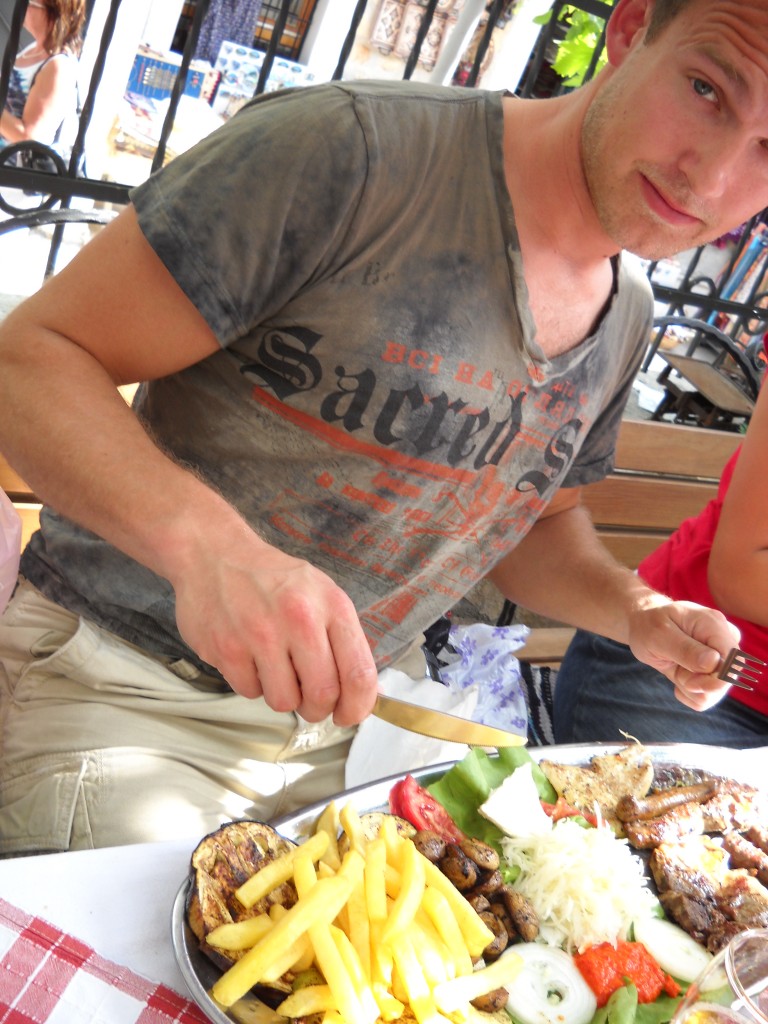
I tucked into a cool and refreshing tomato onion salad followed by wonderfully greasy sausages dipped in mustard, and savory roasted potatoes.
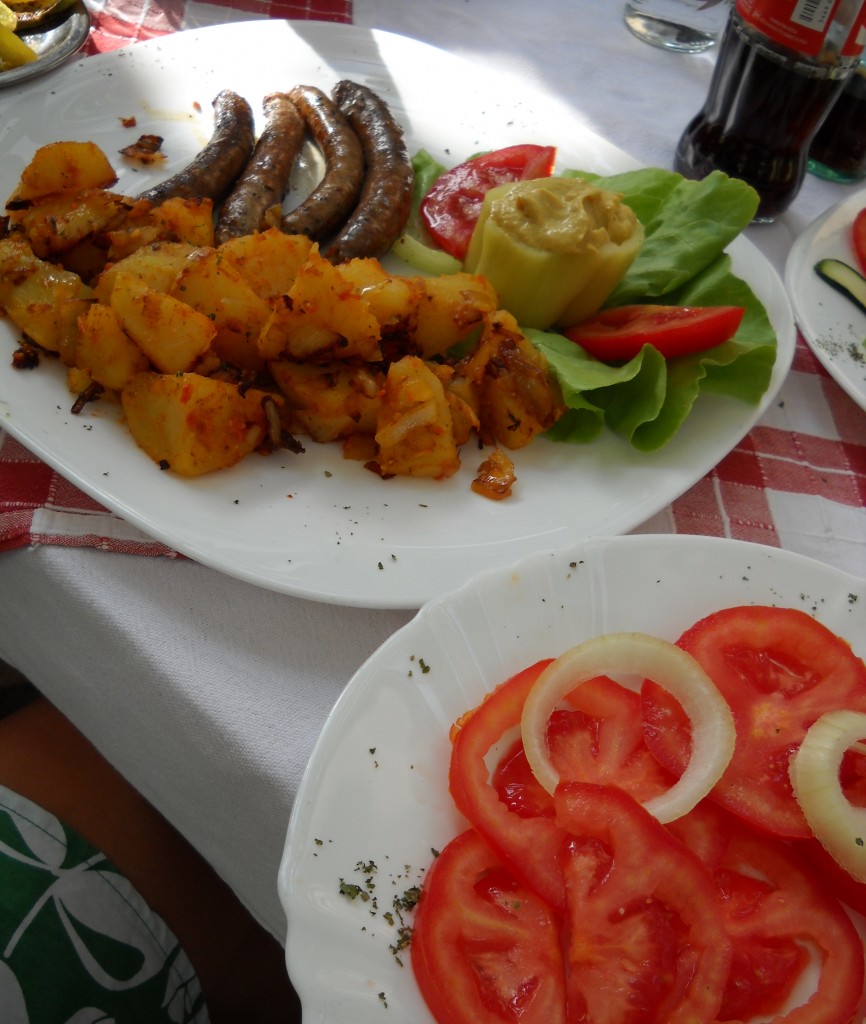
Although we had no room left for dessert, I’ve since learned that Bosnians prefer fresh fruit or simple plain cake for their after dinner treat. In their honor I dined on fresh cherries this week.
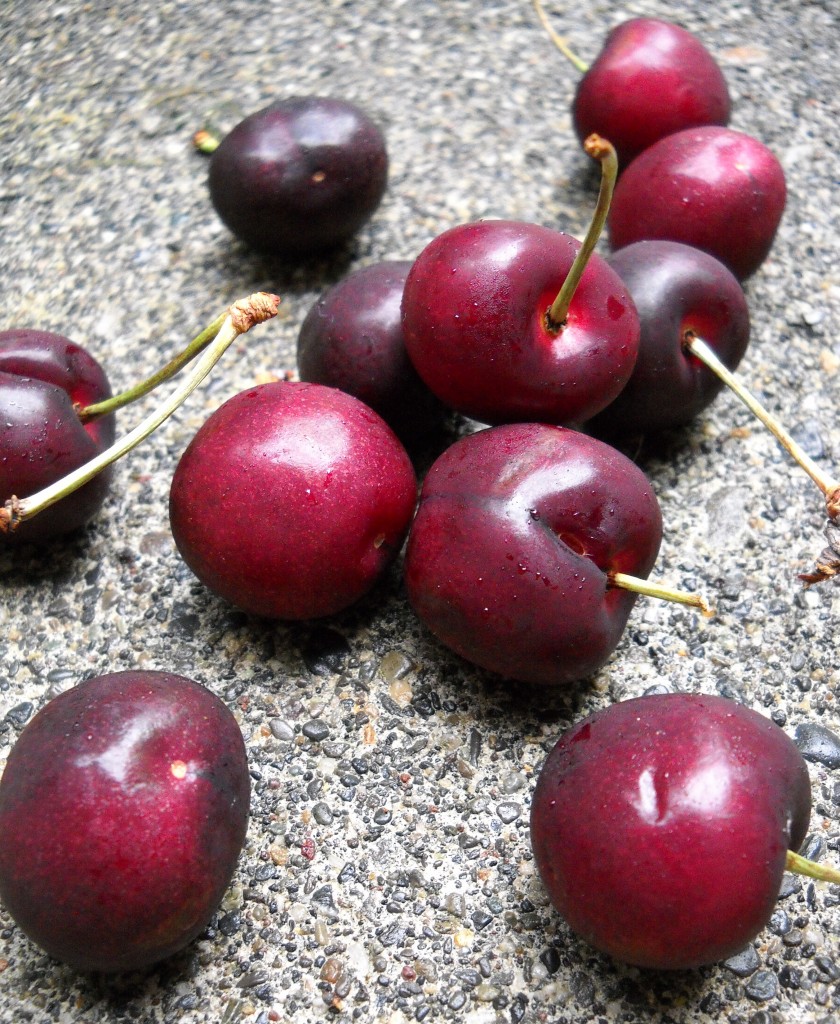
What is your favorite dessert?

by Krista | May 25, 2010 | Spring
Good morning! Before we continue on our jaunt through Bosnia, I want to stop for a moment and say HAPPY BIRTHDAY to my Dad. Happy Birthday, Pa! I love you muchly and am so glad you’re my friend. 🙂

Now…back to Bosnia!
After wending our way past this idyllic lake…
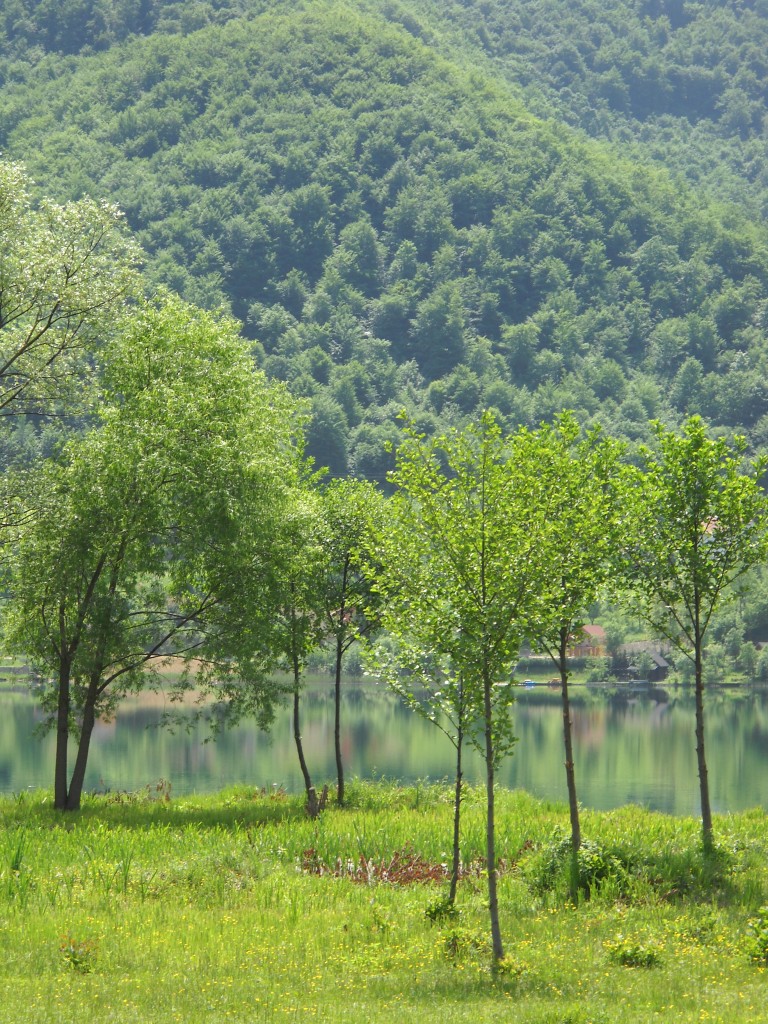
…and through fairytale mountains…we emerged into a valley and began driving through beautiful little villages clustered along the riverbank.
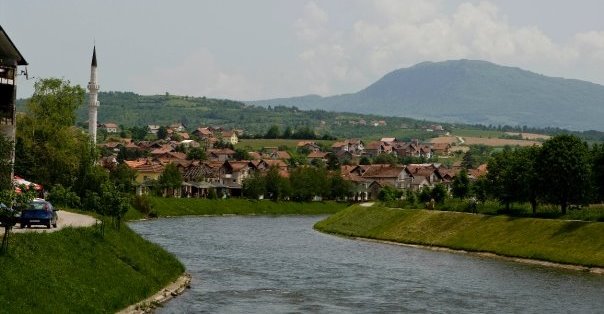
So many things entranced me about the towns we passed: the tidy gardens being readied for spring, farmers pitching hay onto towering stacks, the abundance of balconies festooned with flowers or laundry billowing in the breeze.
Today I’m just going to feature rooftops. They were so fascinating to me! So new, mysterious and exotic. I love how architecture reflects a culture so vividly.
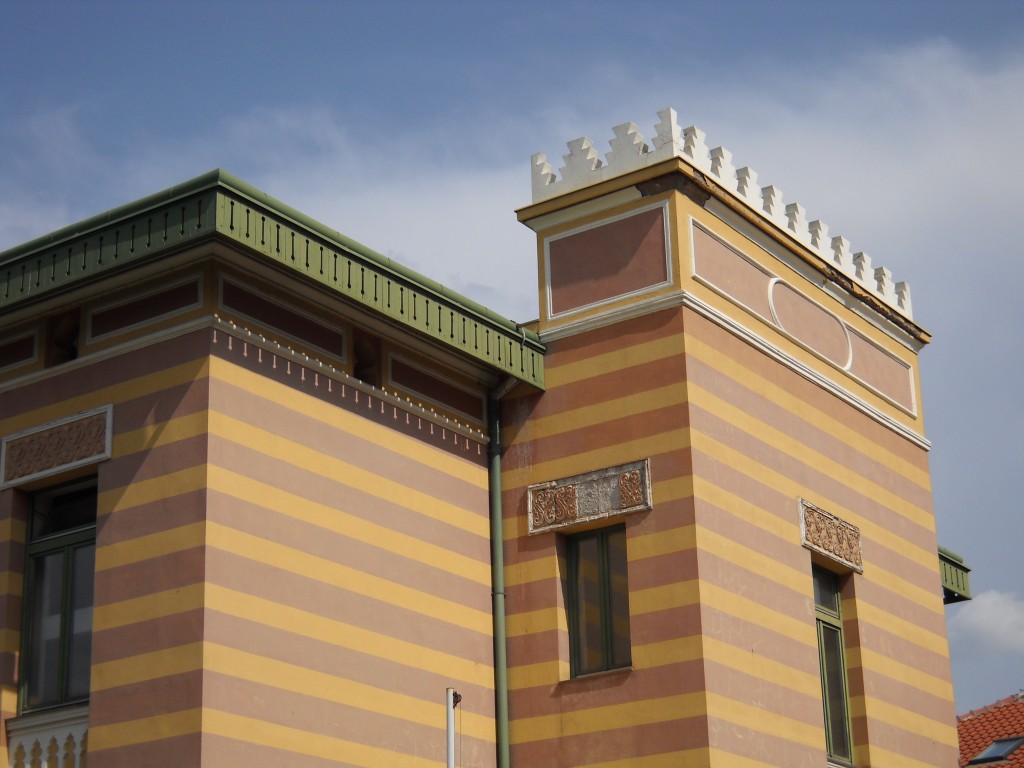
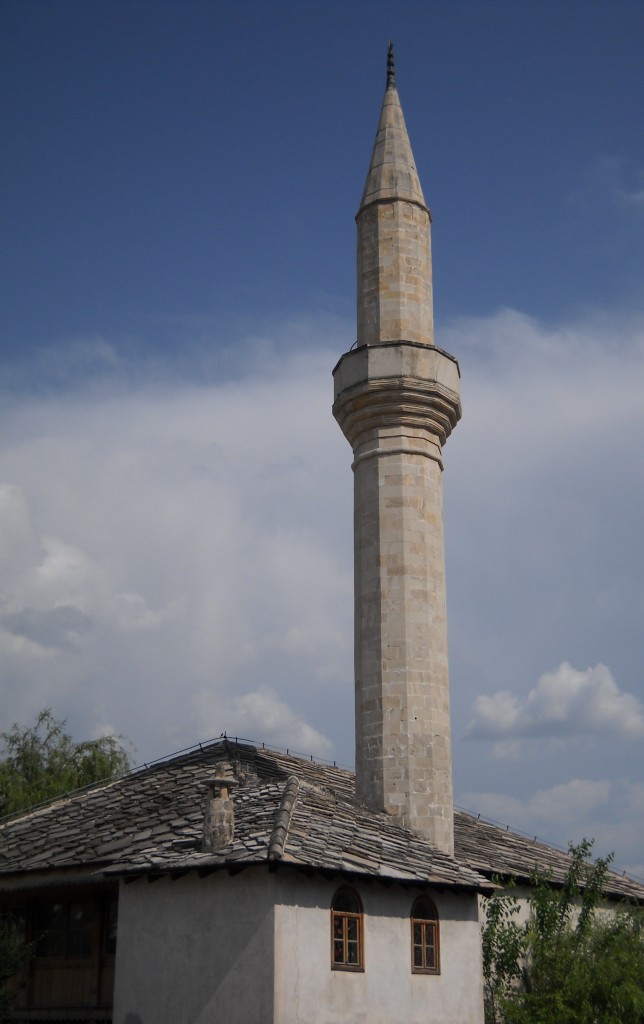
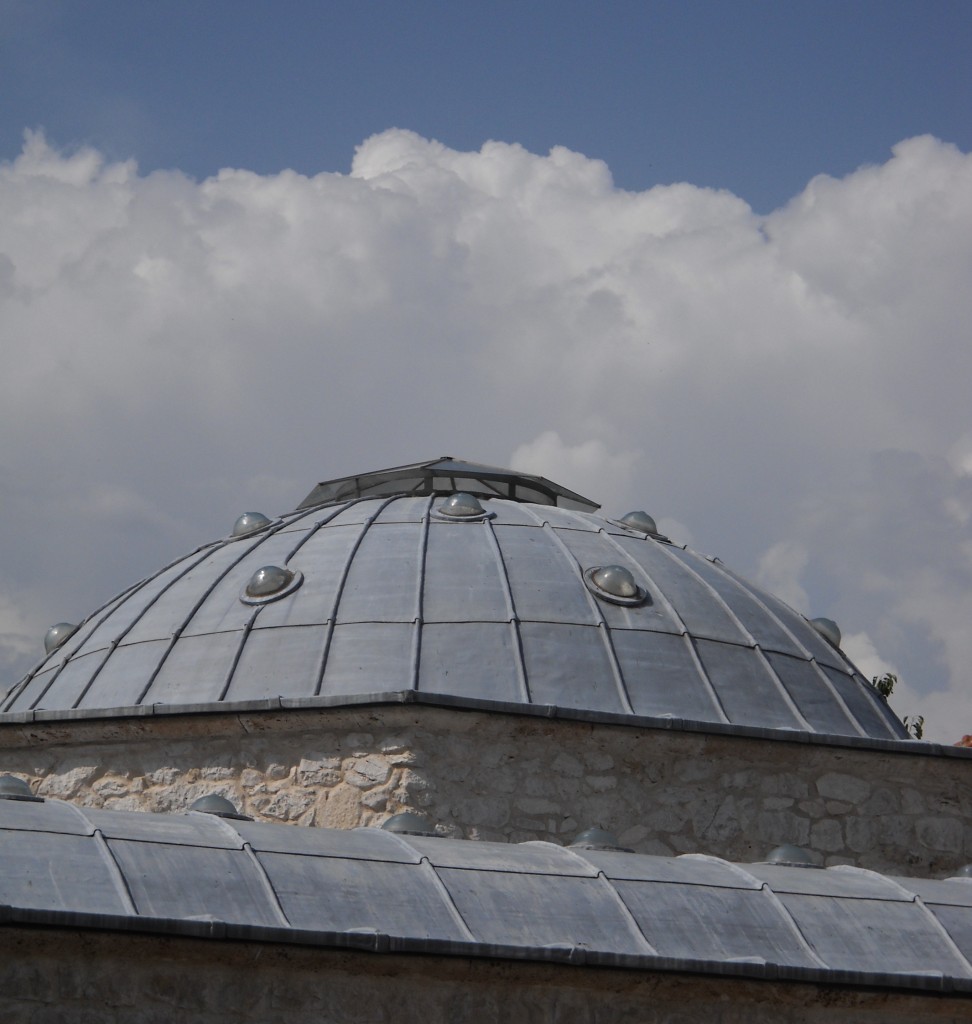
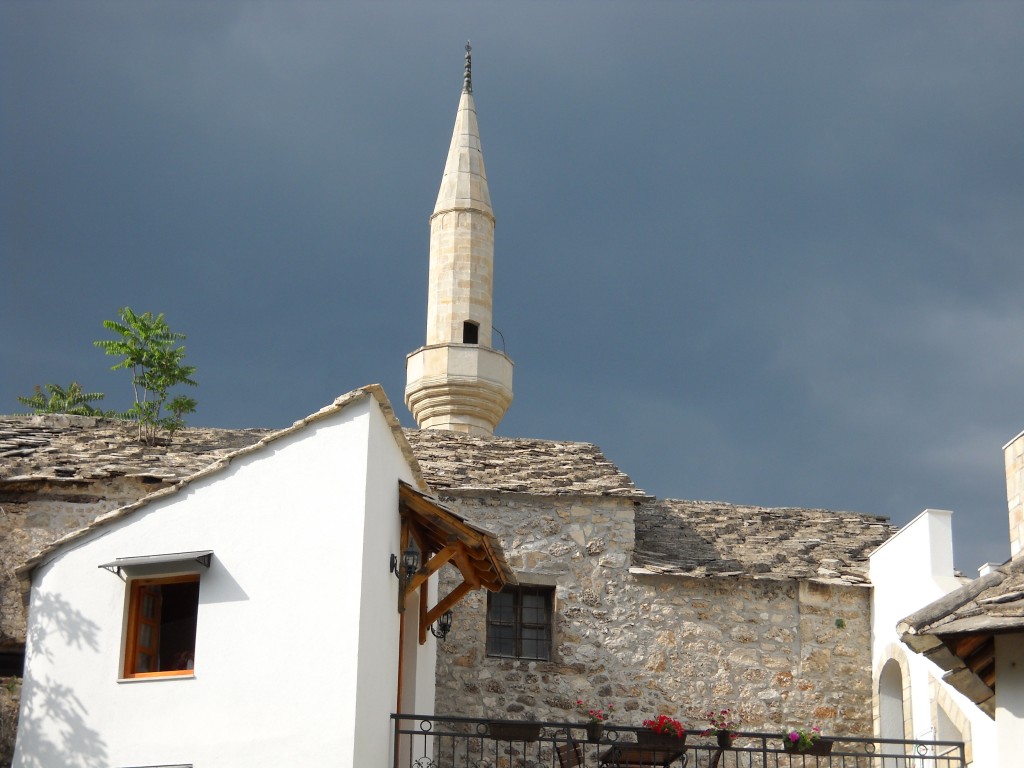
In celebration of these lovely rooftops (any excuse for a party, eh?!), I’m sharing my favorite borscht recipe. I love borscht in any form: hot, sour, savory, sweet. This beauty of a soup is made unique with the addition of juicy apple. Mmmm! Somehow it goes perfectly with the earthy beetroot and has the added bonus of being equally delicious hot or cold. With sunny spring days finally making an appearance, I so enjoy a chilled bowl of borscht topped with soured cream or plain yogurt sprinkled with fresh dill.
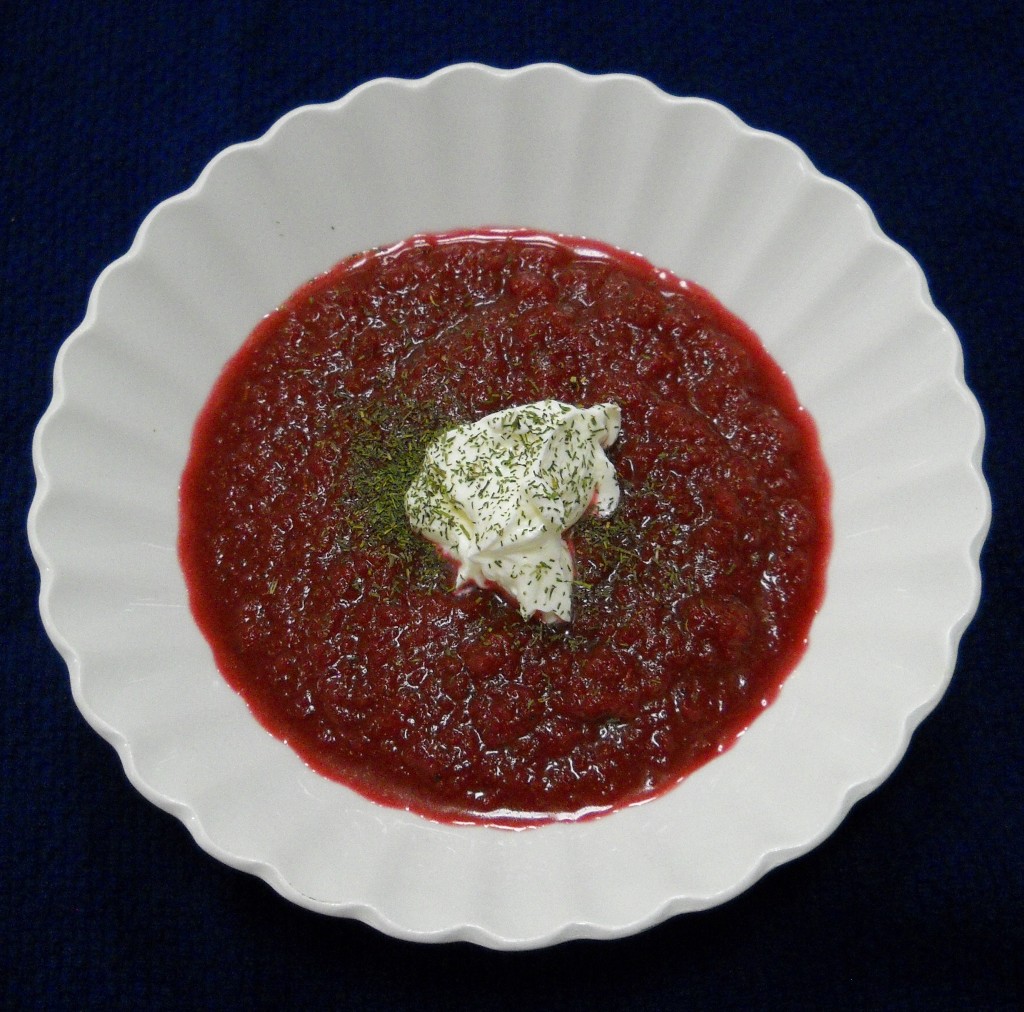
What is your favorite springtime soup?
Borscht with Apples
(Adapted from Soup)
Ingredients:
1 onion, chopped
1 pound raw beetroot, peeled and chopped
2 celery sticks, chopped
1/2 red bell pepper, chopped
1 large cooking apple, chopped
2 Tbsp butter
2 Tbsp sunflower oil
9 cups stock or water
1 tsp cumin seeds
a pinch dried thyme
1 large bay leaf
fresh lemon juice
salt and ground black pepper
Garnish: sour cream, fresh dill
Directions:
- Place chopped vegetables and apple in large saucepan with butter, oil, and 3 Tbsp stock. Cover and cook gently for about 15 minutes, shaking pan occasionally.
- Stir in cumin seeds and cook for 1 minute, then add remaining stock, thyme, bay leaf, lemon juice, and seasoning to taste.
- Bring mixture to boil, then cover pan and reduce heat to gentle simmer. Cook about 30 minutes.
- Strain vegetables and reserve liquid. Process the vegetables i a food processor or blender until they are smooth and creamy.
- Return vegetables to pan, add reserved stock and reheat. Check seasoning.
- Divide into individual serving bowls. Garnish with swirls of soured cream and a frew sprigs of fresh dill.

by Krista | May 18, 2010 | Spring
After our wild drive through the back country of Bosnia and discovering this oh-so-gorgeous lake, we continued to meander through thickly-forested mountains, catching our breath at towering cliffs, turquoise lakes, and pristine rivers cascading through deep, rocky gorges. Although five members of our party were very talkative womenfolk, silence reigned as we gazed in absolute awe and delight at the stunning vistas on every side. I felt that we had stumbled into a magical fairyland. THIS was where giants lived and trolls fought and beautiful maidens spun things in tiny cabins deep in the forest.
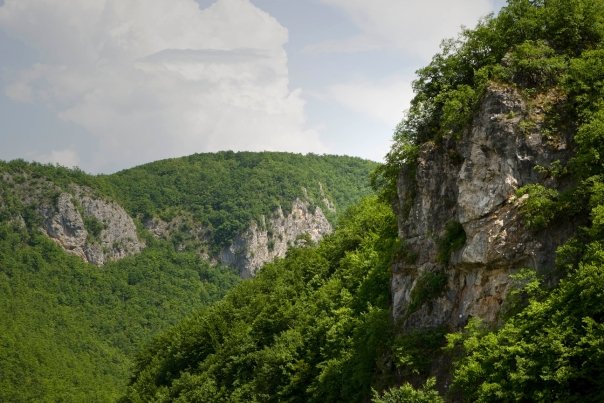
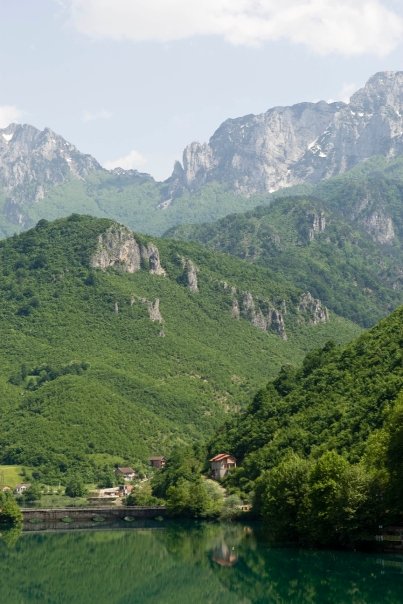
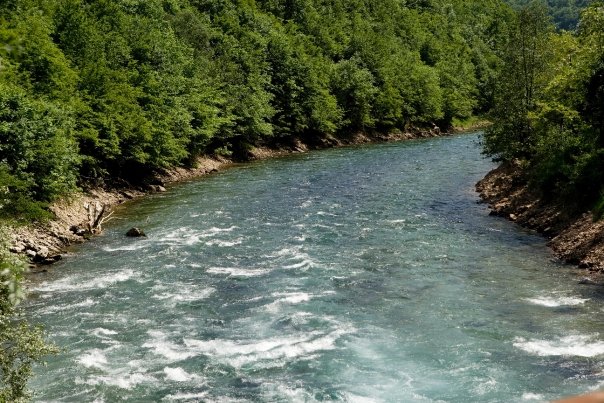
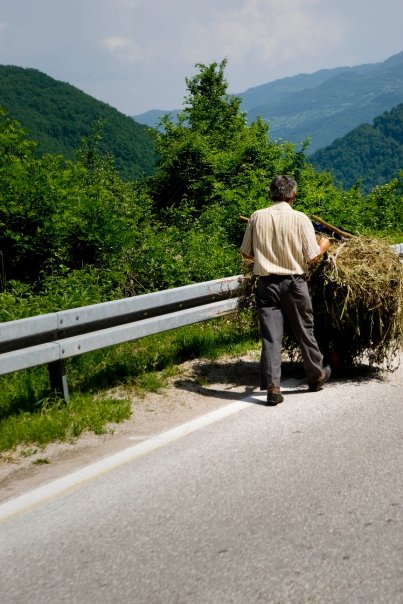
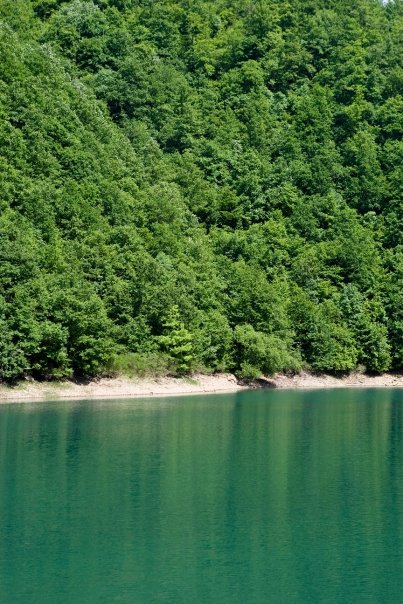
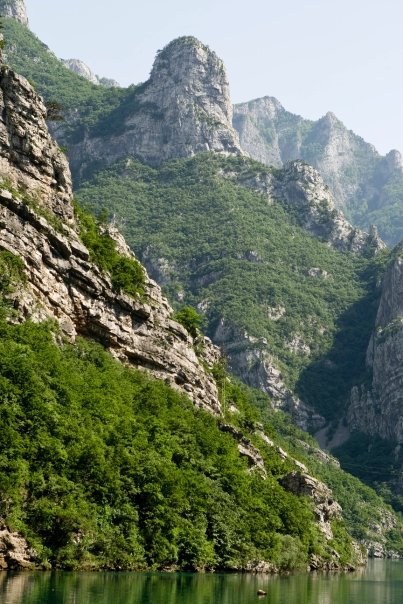
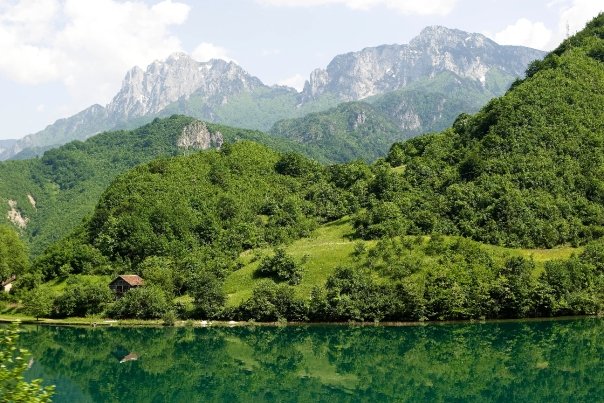
In homage to this beautiful country, I researched some of the exquisite food we ate while we were there, and stumbled upon recipes for a dish I absolutely loved: cevapi.
Looking very much like American breakfast sausages, these lovely morsels are a combination of ground beef, lamb and pork, mixed with onions and garlic, and are served in flat bread or pita and topped with an assortment of condiments depending on the specific Balkan region you’re in.
I did not have ground lamb or pork, so I substituted half a ham. I grated it finely and added it to the beef, mixed in grated onion, pepper, salt, finely minced garlic, 1 tsp of baking soda and an egg white to bind it together. Taking a small handful of meat mix, I molded it into the shape of a breakfast link, repeating until all the meat was used, then covered the cevapi and chilled it for an hour. (The combination is not very wet and must be chilled for at least an hour to allow the flavors to meld and the mixture to bind.) Finally I fried them until they were nicely browned on all sides.
Traditionally they are served on bread with ajvar (a roasted pepper spread), diced onions, diced bell peppers, tomatoes, and sour cream. I skip the bread entirely and pile on the condiments, or simply dip them in grainy mustard for a quick afternoon snack. They are splendid hot or cold. 🙂
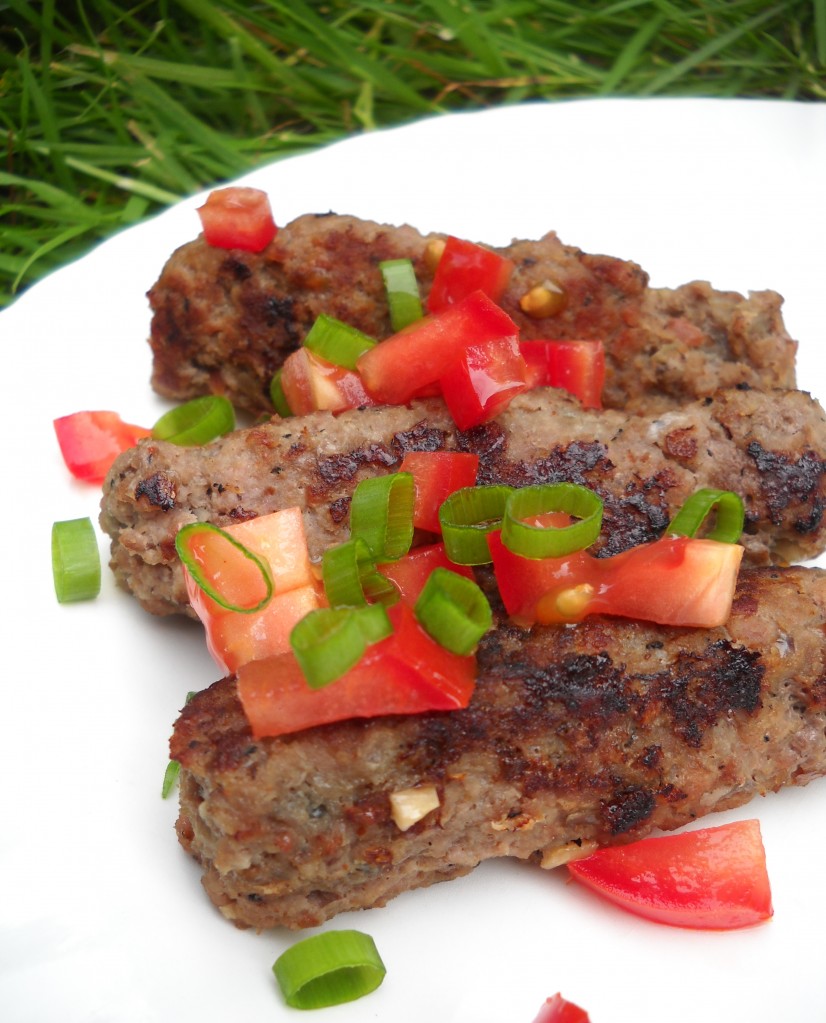
This post has been entered into the Grantourismo HomeAway Holiday-Rentals travel blogging competition.
Rambling Tart version of Cevapi
Ingredients:
1 pound ground beef
2 cups grated ham (traditionally made with 1/2 pound ground pork and 1/2 pound ground lamb)
4 cloves minced garlic
1 red onion, grated
1 tsp baking soda
1 egg white
Salt and pepper to taste (you won’t need much salt at all if you use ham instead of ground pork/lamb)
Flat bread or pita
Toppings: ajar, chopped onion, bell pepper, tomato and sour cream.
Directions:
- Mix everything.
- Mold into breakfast link sized pieces. Chill for 1 hour.
- Fry or grill until browned on all sides.
- Serve with flat bread/pita, chopped onion, bell pepper, tomato and sour cream.













































